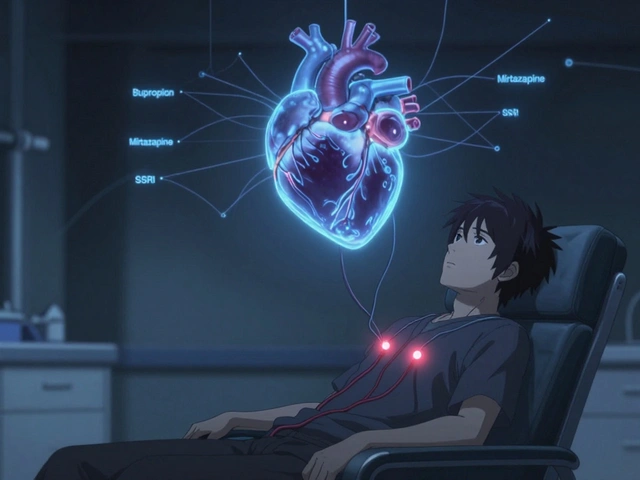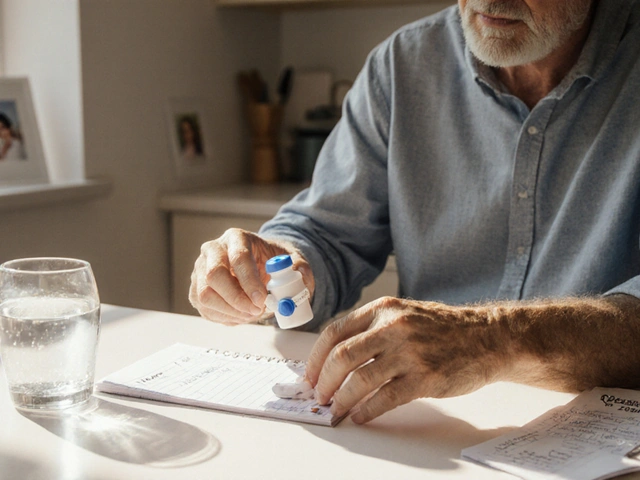Quick Takeaways
- Hyponatremia is a low‑sodium condition that can be life‑threatening if not treated.
- Eating disorders such as anorexia nervosa and bulimia nervosa create several pathways to develop hyponatremia.
- Common triggers include excessive water drinking, laxative abuse, and rapid refeeding after starvation.
- Early symptoms are confusing - headache, nausea, and mild confusion can mimic the disorder itself.
- Prompt medical assessment, controlled fluid replacement, and addressing the underlying eating disorder are essential for recovery.
What Is Hyponatremia?
When the body’s sodium level falls below 135mmol/L, the condition is called hyponatremia - a state where too much water dilutes the blood’s sodium concentration, disrupting cellular function. Sodium is the main electrolyte that helps regulate fluid balance, nerve transmission, and muscle contraction. Even a modest drop can cause swelling of brain cells because water moves into them to equalize concentrations, leading to cerebral edema and potentially seizures.
How Eating Disorders Set the Stage for Low Sodium
Eating disorders aren’t just about food choices; they hijack the body’s hormonal and renal systems. Below are the three most common pathways that link disordered eating to hyponatremia.
1. Purging Behaviors and Fluid Shifts
Individuals with bulimia nervosa or the purging subtype of anorexia often induce vomiting or misuse laxatives. Both actions cause rapid loss of electrolytes, especially sodium and potassium. To compensate, many turn to excessive water intake, believing it will “flush out” the system. This creates a double‑hit: electrolyte loss plus dilution, pushing serum sodium down.
2. Water‑Loading Practices
Some patients deliberately drink large volumes of water before weighing themselves, hoping to mask weight fluctuations. Consuming 4-6liters in a short period can overwhelm the kidneys’ ability to excrete free water (max ~0.9L/hour), especially when ADH (antidiuretic hormone) is inappropriately high due to stress or dehydration. The result is a rapid fall in sodium concentration.
3. Refeeding Syndrome
After prolonged starvation, the body’s insulin response spikes when carbs are re‑introduced. Insulin drives potassium, magnesium and phosphate into cells, but it also promotes water retention. If fluids aren’t carefully managed, the sudden shift can dilute sodium. Refeeding syndrome is most common in severe anorexia nervosa cases where weight <75% of ideal is restored too quickly.
Warning Signs You Shouldn’t Ignore
Because many early symptoms mimic the psychological distress of an eating disorder, clinicians and loved ones need to stay alert. Typical red‑flags include:
- Persistent headache or “brain fog” that doesn’t improve with rest.
- Nausea, vomiting, or abdominal cramps out of proportion to eating behavior.
- Unexplained muscle cramps, weakness, or twitching.
- Seizures or sudden loss of consciousness - a medical emergency.
- Rapid weight fluctuation accompanied by excessive fluid intake.
Lab Diagnosis: What the Numbers Tell You
A basic metabolic panel is enough to catch hyponatremia. Key thresholds:
- Serum sodium 135-145mmol/L - normal.
- 130-134mmol/L - mild hyponatremia (often asymptomatic).
- 125-129mmol/L - moderate; headache, nausea, and gait instability appear.
- Below 125mmol/L - severe; risk of seizures, coma, and respiratory arrest.
Additional labs (serum osmolality, urine sodium, and urine osmolality) help pinpoint whether the low sodium is due to excess water intake, renal loss, or hormonal imbalance.

Treatment Roadmap: Stabilize, Replace, and Recover
Management must address both the electrolyte crisis and the underlying eating disorder.
- Immediate medical stabilization: In severe cases, hypertonic saline (3% NaCl) is given intravenously in a controlled setting to raise sodium by no more than 8mmol/L in 24hours, avoiding rapid shifts that cause central pontine myelinolysis.
- Fluid restriction: Limit free water to 800-1000ml per day until serum sodium begins to rise.
- Electrolyte replacement: Oral or IV potassium and magnesium are added because correcting sodium alone can worsen other imbalances.
- Address the trigger: If purging or laxative abuse is the cause, medication such as ondansetron (anti‑nausea) or bupropion (for binge‑eating) may be used alongside psychotherapy.
- Refeeding strategy: Start calories at 5-10kcal/kg/day, increase by 200kcal every 2‑3days, and monitor electrolytes every 12‑24hours.
Close collaboration between physicians, dietitians, and mental‑health professionals improves outcomes dramatically.
Prevention: What Patients and Clinicians Can Do
Proactive steps cut the risk of hyponatremia before it spirals.
- Educate patients about the dangers of “water loading” and promote individualized fluid goals.
- Monitor weight‑change patterns daily; sudden spikes often signal excessive fluid intake.
- Screen for laxative and diuretic misuse during routine visits.
- When initiating refeeding, use a certified nutritionist to design a gradual calorie plan.
- Consider routine serum sodium checks for anyone with a diagnosis of anorexia nervosa or bulimia nervosa who reports binge‑purge cycles.
Eating Disorder Types and Their Hyponatremia Risk
| Disorder | Typical Behaviors That Lower Sodium | Risk Level (Mild / Moderate / Severe) |
|---|---|---|
| Anorexia nervosa - restrictive | Severe caloric restriction, occasional binge‑purge | Moderate (re‑feeding syndrome) |
| Anorexia nervosa - binge‑purge | Frequent vomiting, laxative abuse, water loading | Severe |
| Bulimia nervosa | Compulsive binge‑purge cycles, high fluid intake before weigh‑ins | Severe |
| Binge‑eating disorder | Occasional excessive water intake, limited purging | Mild to Moderate |
| Other specified feeding or eating disorder (OSFED) | Variable - often includes laxative misuse | Variable |
Frequently Asked Questions
Can mild hyponatremia resolve on its own?
Mild cases (sodium 130‑134mmol/L) often improve by simply limiting free‑water intake and correcting the underlying behavior. However, regular monitoring is crucial because the condition can slip into moderate or severe ranges quickly.
Is it safe to drink a lot of water after an eating‑disorder relapse?
No. Excessive water intake can overwhelm the kidneys, especially when the body is already dehydrated from purging. Aim for 2-2.5L of fluid per day unless a clinician advises otherwise.
What’s the difference between hyponatremia and dehydration?
Dehydration means a loss of total body water, often raising sodium concentration (hypernatremia). Hyponatremia is the opposite - too much water relative to sodium, leading to dilution. Both can occur in the same patient if fluids are lost via vomiting but then replaced with plain water.
How fast should sodium be corrected in severe cases?
Guidelines recommend raising serum sodium by no more than 8mmol/L in the first 24hours and 18mmol/L in 48hours to avoid osmotic demyelination syndrome.
Are there long‑term brain effects after a hyponatremic episode?
If corrected promptly, most patients recover fully. Delayed or overly rapid correction can cause permanent neurological damage, highlighting the need for careful medical supervision.
Next Steps for Readers
If you or someone you know is dealing with an eating disorder, keep a few practical actions in mind:
- Schedule a medical check‑up that includes a basic metabolic panel - don’t wait for symptoms to worsen.
- Track fluid intake for a week; bring the log to your clinician.
- Seek a multidisciplinary team: physician, registered dietitian, and therapist experienced in eating‑disorder care.
- Educate yourself about the signs of hyponatremia; early detection saves lives.
- Remember that recovery is a marathon, not a sprint. Gradual, evidence‑based refeeding beats rapid, risky fixes every time.
Understanding the link between low sodium and disordered eating empowers you to catch problems early, intervene safely, and support lasting health.





Yojana Geete
September 28, 2025 AT 16:44Oh the tragedy of low sodium masquerading as the eating disorder itself a cruel twist of fate that many ignore the body screams for help yet the voice is drowned in whispered diets and silent tears
Jason Peart
October 5, 2025 AT 03:44Hey folks, I just wanted to share a few thoughts on hyponatremia and eating disorders because this is something that hits close to home for many of us.
First off, remember that low sodium isn’t just a lab number, it’s a real life threat that can sneak up while you’re trying to recover.
Second, the water‑loading trick before weigh‑ins is a dangerous game – your kidneys simply can’t dump that much water fast enough, especially when the body is already stressed.
Third, purging through vomiting or laxatives robs you of essential electrolytes, and then drinking gallons of water feels like a fix but actually dilutes what little sodium you have left.
Fourth, when you finally start refeeding, the insulin surge can pull not just glucose but also potassium, magnesium and phosphate into cells, dragging water along and further lowering sodium.
Fifth, symptoms like headache, nausea, and mild confusion can be mistaken for the psychological haze of an eating disorder, so always get labs checked if you notice anything odd.
Sixth, a gentle reminder: medical supervision is key – you don’t want to self‑manage fluids when the balance is this delicate.
Seventh, education is empowerment; knowing the signs early can save a life.
Eighth, if you’re supporting someone, watch for excessive water drinking, sudden weight changes or persistent fatigue – these could be red flags.
Ninth, ask doctors about safe rehydration protocols – sometimes oral rehydration solutions are better than plain water.
Tenth, don’t be ashamed to talk about it – the stigma around “drinking too much water” can keep folks silent.
Eleventh, be patient with yourself during recovery; your body needs time to reset its electrolyte homeostasis.
Twelfth, keep a journal of fluid intake and any symptoms, this data helps clinicians tailor treatment.
Thirteenth, know that hyponatremia can happen at any stage of an eating disorder, not just the extreme phases.
Fourteenth, mental health support goes hand‑in‑hand with medical care; anxiety often fuels the urge to over‑hydrate.
Fifteenth, stay hopeful – with proper care, sodium levels normalize and the brain heals.
Sixteenth, share this info with friends or support groups so we all stay vigilant.
Hanna Sundqvist
October 11, 2025 AT 14:44Honestly you think it’s just about water? There’s a whole hidden agenda behind those “health tips” that the mainstream doesn’t want you to see.
Jim Butler
October 18, 2025 AT 01:44Absolutely, the physiology is crystal clear and the clinical guidelines are unambiguous. 📚💡 It is essential to monitor serum sodium closely when treating patients with purging behaviors. 📈 The kidneys have a maximum free water excretion capacity of roughly 0.9 L per hour, and exceeding this can precipitate severe hyponatremia. 🕒 Therefore, clinicians must assess fluid intake patterns, especially in individuals who engage in pre‑weighing water loading. 🏋️♂️ Moreover, refeeding protocols should incorporate gradual electrolyte replacement to mitigate rapid shifts. 🥣 In summary, a multidisciplinary approach encompassing medical, nutritional, and psychological expertise yields the best outcomes. 🧠💪
Ian McKay
October 24, 2025 AT 12:44While the previous comment is well‑intentioned, it omits that excessive emphasis on “monitoring” can create anxiety in patients; a balanced approach is preferable.
Deborah Messick
October 30, 2025 AT 22:44One must also consider the moral dimensions of promoting extreme weight‑loss tactics; glorifying water‑loading is an affront to responsible health education.
Jolanda Julyan
November 6, 2025 AT 09:44From a practical standpoint, let me break it down simply – first, the body’s sodium reservoir is finite; second, when you drink a litre of water every ten minutes you are outpacing the kidneys; third, the resulting dilution can cause cerebral swelling which is not a trivial matter; fourth, the symptoms can masquerade as anxiety or fatigue, making diagnosis tricky; fifth, the key is to educate patients early about safe hydration practices; sixth, clinicians should ask targeted questions about pre‑weighing rituals; seventh, incorporate electrolyte‑rich beverages rather than plain water when refeeding; eighth, maintain a supportive environment that does not shame the individual; ninth, monitor labs daily during the acute phase; tenth, adjust fluid plans based on urine output and serum osmolality; eleventh, involve dietitians to design low‑sodium yet nutritionally adequate meals; twelfth, provide mental health resources to address underlying anxieties; thirteenth, remember that recovery is a marathon, not a sprint; fourteenth, celebrate small victories to sustain motivation; fifteenth, stay vigilant because relapse can happen months later.
Emily Rossiter
November 12, 2025 AT 20:44Thanks for the thorough rundown. It’s important to remember that every person’s journey is unique, so tailoring fluid and electrolyte management to individual needs makes a big difference.
Renee van Baar
November 19, 2025 AT 07:44The supportive tone in the previous comment is appreciated; adding that consistent follow‑up appointments can catch shifts in sodium levels before they become critical.
Mithun Paul
November 25, 2025 AT 18:44From an analytical perspective, the data suggests a statistically significant correlation (p < 0.01) between the frequency of purging episodes and the incidence of hyponatremia, underscoring the necessity for rigorous monitoring protocols.
Sandy Martin
December 2, 2025 AT 05:44I absolutely agree with the need for precise monitoring; however, note that in practice, patients often misreport their water intake, which can skew lab interpretations.
Steve Smilie
December 8, 2025 AT 16:44One must not overlook the audacious flamboyance of the medical lexicon when delineating the pathophysiological tapestry of electrolyte derangements-a veritable chiaroscuro of clinical nuance.
Josie McManus
December 15, 2025 AT 03:44yeah i get it, the info is solid but sometimes the docs sound like robots, just speak human and keep it real for the folks battling these issues.
Heather Kennedy
December 21, 2025 AT 14:44Regarding the electrolyte homeostasis, the interplay between ADH secretion and renal free‑water clearance warrants a nuanced approach, especially when applying evidence‑based protocols.